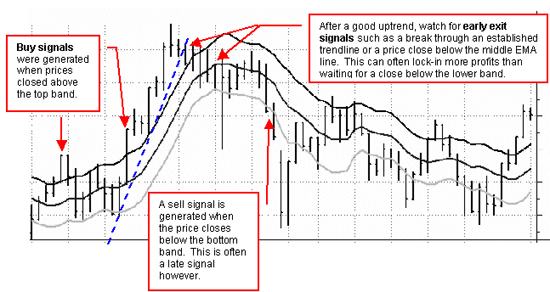Keltner Channel
The Keltner Channel is based on the Average True Range and
is sensitive to volatility. It may be used in place of standard deviation
(Bollinger) bands or percentage envelopes.
Overview
- The Keltner Channel is made up of two bands plotted around an
Exponential Moving Average (EMA), usually the 20-day EMA.
- Prices breaking through the bands often produce buy and sell signals.
The indicator was originally developed by Chester Keltner and later modified
by Linda Raschke to use an average true range (ATR) calculated over 10
periods.

Interpretation
As with all envelope or band systems, the probability is that price will
remain within the envelope. When price breaks though the envelope, it can be
taken as a signal to either buy or sell.
When prices close above the top band, this often means a
breakout in upward volatility to be followed by higher prices. When prices
close below the bottom band, prices are expected to move lower.
In a rising market the middle line, or 20 period EMA, should
provide support. Conversely, in a falling market it tends to provide resistance.
As with all trend following systems, the Keltner Channel works
well in up trends or down trends, but doesn't work well in a sideways channel.
As a trend following system it is not meant to catch tops or bottoms.
Keltner channels should be used in combination with other
indicators, such as RSI or MACD, to provide confirmation of the strength of a
market. An exit strategy utilizing trendlines and other indicators can be
particularly important, as can be seen from the example above. Waiting for the
price to close below the lower band often erodes much of the potential profits
from a good move.
The calculation for Keltner Channel, based on ATR, is as
follows:
- For the top or Plus Band, the ATR is calculated over 10 periods, doubled
and added to a 20 period exponential moving average
- For the bottom or Minus Band, the ATR is calculated over 10 periods,
doubles and subtracted from a 20 period exponential moving average
Signals
- When prices close above the plus band, it is a signal of strength and
rising prices
- When prices close below the negative band, a signal that prices will
drop is indicated
- Signals stay in effect until the prices close across the opposite band.
This should often be tempered, however, with the use of other indicators to
provide better exit opportunities.
Further information
Also see the overview on Envelopes & Bands; as well as
Bollinger Bands, the
Price Channel
indicator, and Average True Range.

